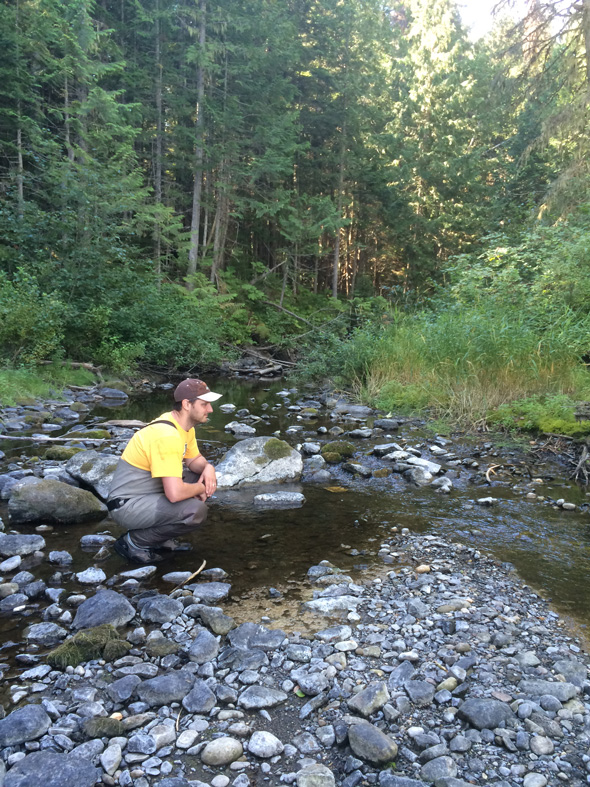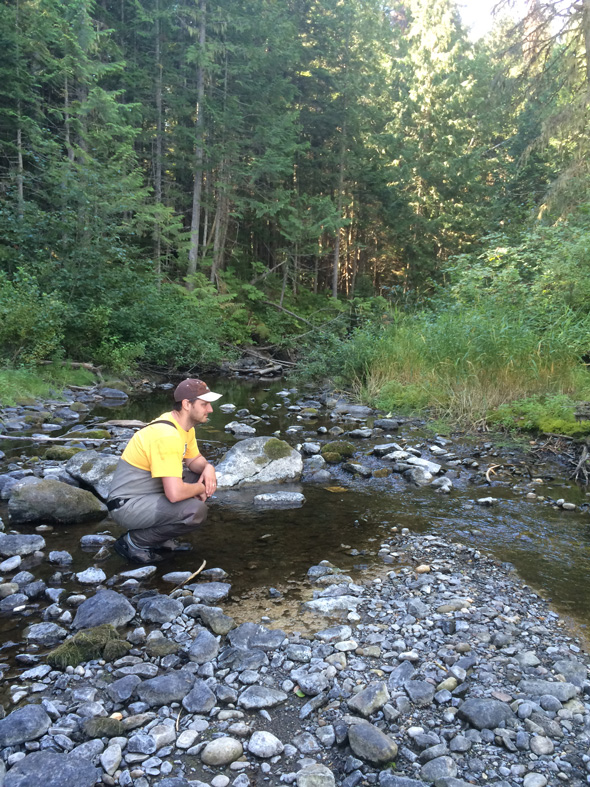
By LeRae Haynes —
Strategically located to provide immediate and ongoing data on the Mt. Polley Mine breach, the University of Northern British Columbia (UNBC) Quesnel River Research Centre has been a source of important information on the breach for the past year. Research scientists at the facility include centre manager Sam Albers, who says the upcoming annual open house on October 3 is a great opportunity for people to ask questions and have discussions about what the centre has done this past year and what is coming up in the near future.
Albers explains he works closely with UNBC faculty members as part of a landscape ecology program associated with the Quesnel Lake area.
“UNBC scientists Phil Owens and Ellen Pettigrew work with Masters and PhD students on projects like salmon, sediment tracing, and the impact of the Mt. Polley Mine breach,” he says. “We also work with people from Canada and from around the world. They’ll come to me with research questions on fish, watershed science, and the study of lakes, for example, and if we have the equipment and the facilities to answer the question, we will take it on.”
Quesnel Lake is a major producer of Sockeye salmon within the Fraser River system and the way the nutrients and sediment move through the system is unique. The lake was relatively pristine and has the attractiveness of a fairly undeveloped area; but, that changed after the Mt. Polley Mine breach.
“It’s good that we can serve as a hub of academic research on the breach disaster,” says Albers. “We’ve been very active putting together proposals to get funding to expand the research regarding the breach. We have two students now looking at salmon and the ins and outs of how they return nutrients back to Horsefly River and Horsefly Bay. They’re looking at the larger impact of that on the whole productivity of the lake.”
The methods they’ve used to study the breach are methods they’ve used before. “We are only 23 km away from Mt. Polley Mine, and when it happened we were able to take some of our instruments and put them in the water right away,” says Albers. “Thanks to the community of Likely, UNBC, and the province of BC having this facility in operation, we were in the right place at the right time to help with research on the breach almost immediately.”
Researchers at the centre used historic in-lake mooring data, newly collected data, and publicly available information from the British Columbia Ministry of the Environment, Environment Canada, and the Mount Polley Mining Corporation to compare pre-breach conditions to changes in the lake.
Albers, who has been at the research centre since 2008 and the manager since 2012, notes research since the breach in August, 2014 has been consistent and ongoing. “The first couple of months were very intense: we were putting in long hours trying to get a handle on it right away,” he explains. “Today, we continue to collect samples on a similar frequency; it’s more measured but we’re still going full bore on this.”
I hope that when my own daughter is grown she’ll be able to stand on a river bank and see the shine of red from salmon all across the water…”
It’s far too early to tell exactly what will happen. “The research will evolve over the next few years: it’s important to update the data base all along,” says Albers. “It’s the biggest source of information. I hope we learned through all this how to deal with this kind of disaster, and how truly valuable it is to have crucial baseline data immediately available—it’s the best way to measure the impact.”
The local community played a big role in re-opening the centre. Formerly a federal facility, it was closed for a while and in a minimal state for a few years. “In 2003, UNBC took it over, and the community was a big part of that,” he says. “There were lots of letters written—they didn’t let the place fall to pieces. A lot of people here take a lot of pride in this facility.”
Staff at the centre is gearing up to welcome the public at the annual open house on October 3 starting at 10 a.m. “This is a key event for us: a chance for people to see what we’ve been doing for the past year,” says Albers. “Last year, with the breach, we completely shifted our focus to presenting up-to-date findings, especially in the first two months after it happened. Our future plans include a big grant proposal we submitted in April, and we hope to have an exciting announcement at the open house.
“This is a great opportunity for people to ask questions and have discussions with us as an independent research group speaking to what the scientific data is telling us.”
B.C. Rivers Day on September 27 generates public awareness about the province’s waterways, and is a chance to celebrate our rivers and reflect on what we have to lose if we fail to take better care of them.
Albers agrees. “In light of BC Rivers Day and the breach a year ago, we should celebrate the incredible Quesnel Lake and Quesnel River basin wilderness out here,” he says. “It’s still an unregulated water system, where every year a whole mass of fish appear out of nowhere.
“With things like climate change and mine breaches you worry that the fish are in for a rough time of it. I hope that when my own daughter is grown she’ll be able to stand on a river bank and see the shine of red from salmon all across the water—it’s a beautiful thing to see.”
LeRae Haynes is a freelance writer, songwriter, co-producer of “Pursicles,” and the community co-ordinator for Success by 6. She is also the instigator of a lot of musical shenanigans in Williams Lake including “Borderband” with kids and is a member of the “Perfect Match” dance band.


